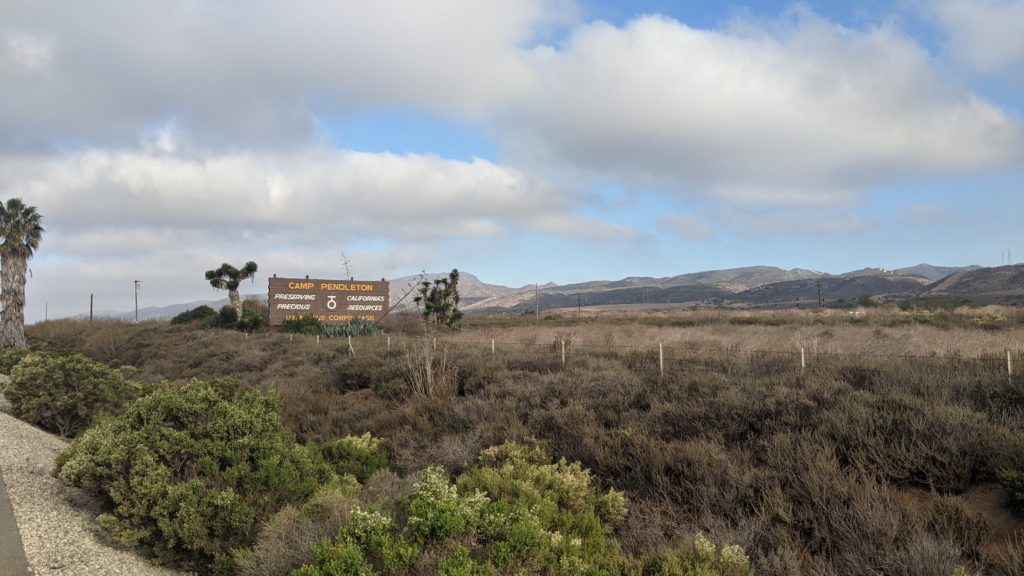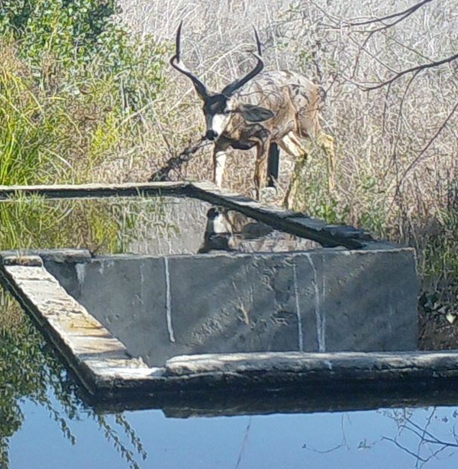
Camp Pendleton’s hunting opportunities on a diverse landscape
BY MIKE STEVENS
OCEANSIDE – The sign says “Camp Pendleton – Preserving California’s Natural Resources.” Over the past three decades and as recently as this morning, I’d see that sign a million times whenever I was heading north on Interstate 5 over the base. It was always thought provoking, but it was embarrassingly late in life before I realized what it really meant. As a kid, I’d look east over the dirt and brush toward the hills serving as the backdrop. Part of me was looking for cool stuff like Marines and tanks and hueys while the other part was thinking, “umm, what natural resources? It just looks like wide-open nothing.”
Thirty or so years later – now taking that route on a daily basis on my commute from San Diego County to the Western Outdoor News office in San Clemente – it hit me. That’s exactly what it’s preserving: wide…open…nothing. Which is really something considering how little of that there is in SoCal, and at gathering at Northern Pine Brewing in Oceanside, I learned it goes way beyond just that.
The event was one that gave me the opportunity to kill two birds with one stone: attend the first “Pint Night” held by the Camp Pendleton extension of the California chapter of Backcountry Hunters and Anglers (BackcountryHunters.org), and gather information for a story I’ve long wanted to write about the fishing and hunting that takes place on the base.
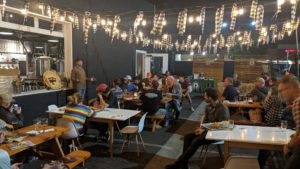
The president of the Camp Pendleton chapter of Backcountry Hunters and Anglers’ (BHA) Armed Forces Program is Brett O’Mara, and he would be introducing the guest speaker that night, Camp Pendleton’s Chief Game Warden, Michael Tucker. His presentation was going to cover the unique dual-species-of-mule-deer situation specific to the base, but I had a short window before that where I could get a solid overview of Pendleton’s big outdoor picture.
O’Mara introduced me to Turner who gave me an incredible overview of the hunting and fishing on base over top-notch beers and BBQ. Marine Corps Base Camp Pendleton covers 125,000 acres and is bordered by Oceanside to the south, Orange County and the Cleveland National Forest to the north and Fallbrook to the east. Its outdoor opportunities are only available to active duty military, veterans and dependents, but Turner likes to say “anyone can hunt and fish on the base, just call this number,” only to then provide the phone number for a local recruiter!
“Some Marines are here for a year or more before they realize there is hunting available,” said Turner.
Due to the transient nature of military life, R3 (recruit, retain, reactivate) programs are even more important than with civilians because new people are always showing up and they’re not there very long. It’s not like grandpa passes it down to dad who then shows his son the ropes. Everyone needs to be essentially treated as a new hunter or angler.
Along with two subspecies of mule deer, Camp Pendleton also hosts respectable populations of ducks, doves, quail, squirrels and other small game, crows and coyotes. I asked if there are turkeys and Turner said, “sometimes,” as they have made their way in on the Fallbrook side of the base, but only a few were confirmed. Due to the amount of training and other military operations, hunting is only available on weekends and certain holidays.
To my surprise, Camp Pendleton also has a very healthy bison herd that originated as a gift from the San Diego Zoo in 1973. As of the most recent count in 2015, the herd now consists of 90 bison which stands as one of only two (along with the herd on Catalina Island) “conservation herds” of bison in the state.
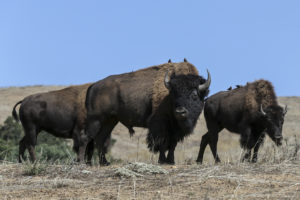
“Bison are from the plains, and they’re not really equipped for mountains,” said Turner. “So, some pull up lame, but with no predators, they’re very healthy, genetically good, and they’re not really managed. Doing nothing with them works.”
While some of the Marines listening in on the conversation lit up when I mentioned the possibility of allowing some hunting for them, there is no hunting for those bison at this time and it didn’t sound like a near-future possibility.
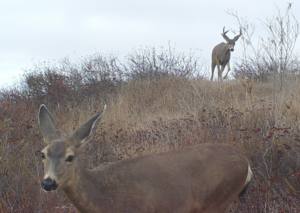
A Marine huey pilot seated with Turner and I identified himself as a hunter from Minnesota, and he was one of those that found out late in his stint at Pendleton that hunting went on in his new backyard. He’s all in now, and I had to chuckle when he showed me photos he took with his FLIR (thermal imaging, night vision, infrared. The cool stuff) equipment from his helicopter at night including mountain lions and a buck with a rack worthy of the cover of any outdoor publication on the planet.
Eventually, Turner needed to take the stage as the guest speaker and talk specifically about Camp Pendleton’s mule deer which, as it turns out, consists of both the southern and California subspecies. This went unnoticed for years until trail cameras on guzzlers revealed both distinct tail-coloration characteristics – solid black for the southern subspecies, while the California subspecies sports more white on the upper tail.
Preliminary data shows the base deer herd is almost a 50/50 split between the two subspecies with the Californians about 6 percent heavier and with antlers 5 percent larger than the southerns. It’s early as far as data gathered (DNA, measurements, locations, habits, etc.) but it’s coming in quick, and much of it is already useful for hunters.
A deer survey done in 2019 with the help of a MQ-9 Reaper (unmanned aerial vehicle or UAV) showed “deer lying motionless in the bushes” and “almost entirely in scrub and chaparral or riparian and bottomland” according to the Turner’s “Herd Info” handout. Short version: they live in bushes, not grasslands. Trail cameras also suggest a slight increase in numbers this year.
As far as the hunting, the base hunt shoots for a harvest of approximately 20 percent of the herd, and that is reached by issuing 250 firearm tags. Archery – which according to Turner, is skyrocketing in popularity on the base – is not yet regulated “due to the limited productivity of the hunters.”
Aside from the hunting features of the area, land within Camp Pendleton includes breeding habitat for birds like the western snowy plover and the California gnatcatcher. Anyone who has driven I-5 through the base knows it also includes a huge stretch of untouched coastal habitat featuring an estuary at the mouth of the Santa Margarita River, coastal dunes and bluffs and salt marsh habitat. The rest is largely oak woodlands, sage, scrub, chaparral and various forms of wetlands. Camp Pendleton also is the home of 18 endangered species.
Anglers get theirs on the base, too. The freshwater scene includes Lake O’Neill, Case Springs pond and Pulgas Lake. There is some budget for stocking Lake O’Neill, mostly warm-water stuff, and Case Springs is very remote and receives minimal angler pressure. The Santa Margarita River also has consistent year-round flows, and studies have gone on to determine if it’s viable or even currently active habitat for Southern California coastal steelhead. At least one weir and fish ladder is in place just in case.
Finally, there is something I can personally attest to. I’ve been lucky enough to get invited several times to visit friends camping at Del Mar Beach on the base, and each time I’ve experienced the best surf fishing I’ve ever had. Surely the miles of untouched – other than the occasional amphibious assault vehicle – stretch of beach just north of there has a lot to do with it.
